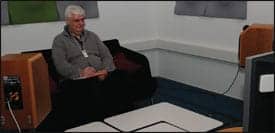The most common leisure activity of retirees is watching television. They spend more time watching television than listening to music, eating at restaurants, and going to church combined. It is the activity that increases the most after retirement; in fact, over half of the increased leisure time people have after retirement is spent watching television.1 According to a recent Nielsen television ratings report,2 US adults over 65 watch more television than any other segment of the population. They watch an average of over 6 hours of TV per day. Television provides not only entertainment; it is also a way to acquire information and to connect to local and world events.3
Unfortunately, hearing-impaired adults have difficulty accessing the spoken information from television. There are many factors that make the speech on television difficult to understand. These factors include the wide variety of speakers, rapid change of topics, rate of speech, background noise, and factors intrinsic to the listener.

|

|

|
| This article was submitted to HR by M. Lisa Sjolander, AuD, a clinical audiologist; Martin Bergmann, MSc, a project manager; and Lise Bruun Hansen, MA, a clinical audiologist, at Oticon AS in Smørum, Denmark. Correspondence can be addressed to HR or M. Lisa Sjolander at . | ||
Televised speech is often presented at twice the rate as conversational speech; this contributes to making TV difficult to understand.4 Many studies show that elderly and hearing-impaired people are particularly negatively impacted by increases in the speed of speech delivery.4-6
Background noise also affects understanding. When watching television, background noise comes from two significant sources. Noise may be part of the TV program itself (eg, music and other sound effects), and noise may come from other sound sources in the listener’s environment.
All of these factors contribute to making television understanding difficult for all listeners. There are also some intrinsic factors—namely, age and hearing loss—that contribute to greater difficulties understanding the speech in TV programming for some listeners. Research indicates that both age and hearing impairment contribute to reductions in the accuracy of speech recognition for rapid and highly variable speech.3,6
There is an easy, though often suboptimal, way to accommodate reduced hearing sensitivity when watching television: turn up the volume. Of course, one obvious problem with turning up the volume is that high TV volume is annoying to other people in the room (or, in some cases, even the neighbors). Excessive TV volume is one of the most common causes of stress in households with a hearing-impaired person, and it is one of the most common reasons for visiting a dispensing professional for the first time.3,7
At the first follow-up visit, the significant other often reports that he/she is happy both with the new hearing aids and with the new lower TV volume.7 However, many hearing-impaired people report that they still struggle to understand speech on TV, even after receiving new hearing aids.
Callahan8 investigated televised speech understanding for elderly adults with and without hearing aids. She found that hearing aids did not significantly improve television speech recognition over no hearing aids for the participants in her study. Closed captioning did improve speech recognition; however, despite this improvement, most adults in the study reported that they preferred to watch television without closed captioning. For many individuals, particularly elderly people, it is difficult to keep up with reading captioned text. Others simply do not enjoy watching TV as much when they have to read.
Research in speech recognition indicates that increasing the volume does not allow hearing-impaired people to understand speech as well as normal-hearing people. Hearing-impaired individuals generally need a more positive signal-to-noise ratio (SNR) to have the same speech recognition as normal-hearing people. Typical hearing care counseling includes a range of techniques, such as face the talker, and ask the talker to speak slower and to rephrase. These techniques are ineffectual for the one-way communication environment of television listening. What can be done to improve television watching for hearing-impaired people?
This article describes an investigation of television speech understanding using hearing aids alone and with the Oticon TV adapter and Streamer. The TV adapter is an augmentative television-watching device that connects to the television. This allows audio information from the television to be sent digitally to the hearing aids via the Streamer. The Streamer is a communication device that relays data from external audio sources (via Bluetooth or a wired connection) to the hearing aids; this allows hearing aids to connect to external sound sources, such as cell phones, MP3 players, or the TV adapter. (In this article, the TV adapter and Streamer are referred to as the TV adapter system.)
The purpose of this study is to compare the speech recognition scores of hearing-impaired listeners for television programming under two conditions: 1) Epoq hearing aids alone, and 2) TV adapter system with Epoq hearing aids.

|

|
| FIGURE 1a-b. Average audiogram of test participants (left ears and right ears, respectively). Bars indicate max and min hearing losses of test people. | |
Materials and Methods
Subjects. A total of 10 people (four females, six males) with bilateral sensorineural hearing loss who are currently using bilateral hearing aids were recruited for this study. The mean age was 65 years and the range was 31 to 81 years. Participants had sensorineural hearing losses ranging from moderate-to-severe to profound hearing (Figure 1).
Amplification. Participants were tested with three styles of Epoq hearing aids: BTE, ITE, and the RITE Power. Each participant used a test Streamer and the TV adapter. A total of eight participants wore their own Epoq hearing aids with fine tuning, and two participants were fit with Epoq hearing aids on the test day because they wore hearing aids that were not compatible with the Streamer. The function of hearing aids was verified prior to the test by participant report, a listening check, and running an electroacoustic analysis of the hearing aids in an AudioScan test box.
Stimuli. The test material included sentences or parts of sentences from Danish television news broadcasts. Sentences were calibrated to have the same average sound level. After each sentence, 45 seconds of silence and blank screen was inserted to provide time for listeners to record their responses on an answer form provided.
Sentences were organized into four lists of 10 sentences each based on sentence difficulty, sex of speaker, and availability of lip-reading information. The objective was to have lists of comparably difficult sentences. The lists were pretested with four normal-hearing subjects. The total percent-correct based on the normal-hearing pretest was between 94% and 96% for each list. Lists had between 75 and 83 total words that were scored individually. Sentences were calibrated to play 62 dBC. This level was rated as comfortable for television watching by normal-hearing listeners.
Noise Competition. Testing was conducted with unmodulated noise playing from two speakers at 45° and 315° (Figure 2). The noise used was speech spectrum shaped unmodulated noise filtered to match the long-term spectrum of the television test material. The level of the noise was selected individually based on speech reception thresholds in noise. The better the participants’ speech reception threshold was, the louder the masking noise; the range of SNRs tested was 0 to +12 dB. The level of the masking noise was varied individually to avoid problems with floor and ceiling effects, which can be a problem for tests with a fixed SNR.

|
| FIGURE 2. Test setup. Speech and visual came from television directly in front, and noise from speakers at 45° and 315°. |
Procedure. Participants were tested with hearing aids alone, and with hearing aids and the TV adapter system. The order of the test conditions was randomized to avoid order effects. Participants wrote down the sentences they heard as accurately as they could during the pauses between sentences. Sentences were played from a television and masking noise was played from two separate speakers.
Before testing, the subject was informed that different settings for watching television were being tested and that his/her task was to write down as much from each sentence as they could. For all testing, the test person wore the Streamer, so the test person did not know which condition was being tested.
Training was conducted with either hearing aids alone or hearing aids and TV adapter system, depending on the test condition being tested. After training, the person was tested with two lists of 10 sentences for each condition: 20 sentences with hearing aids alone and 20 sentences with hearing aids and TV adapter system. Participants had ample time to record the sentences. No repetition was allowed. The order of the lists was randomized to avoid order effects, and lists were not repeated to reduce potential learning effects.
Results
Mean speech recognition scores show significantly greater speech recognition (P < 0.01 using a Wilcoxon matched pair test) with the TV adapter system over hearing aids alone (Figure 3). Individual results showed that all 10 participants had a higher percent-correct score with the TV adapter system and hearing aids than with hearing aids alone. The range of improvement was between 15% and 66% with an average of 45% improvement.
Discussion
Results show that the TV adapter system significantly improves speech intelligibility for television. For participants in this study, the difference between hearing aids alone versus hearing aids plus TV adapter system was the difference between catching a few words (36% correct) to understanding almost everything (81% correct).
The key to improving speech understanding is improving the SNR. The TV adapter system improves the SNR for the television by providing a louder clearer signal that is not affected by the room noise. The signal is not affected by room noise because a digital signal is sent from the TV adapter to the Streamer, which then sends the signal to the hearing aids. Additionally, the volume can be adjusted to individual preferences using the Streamer; this does not affect the TV volume for others.
The TV adapter system is similar to FM systems in that it provides the listener with an improved SNR. The improved speech intelligibility results seen in this test are similar to the large improvements in speech intelligibility in noise with FM systems over hearing aids alone.9

|
| FIGURE 3. Percent correct scores for individual and group with hearing aids and with hearing aids and TV adapter. *Group speech recognition scores were significantly improved (p > .01) with the TV adapter. |
The results from this study indicate that, for many hearing-impaired people, the use of a TV adapter system can improve television understanding—particularly in situations with background noise.
An earlier trial with hearing-impaired listeners in situations with less background noise indicated user-perceived benefit with the TV adapter system over hearing aids alone (“Test of a TV Adaptor,” Oticon A/S, Copenhagen, Denmark, 2009; unpublished data). Participants in that study noted that they benefited from the greater clarity of sound with the TV adapter system over hearing aids alone, and that television volume was at a comfortable level for both family members and the hearing-impaired listener. Furthermore, participants reported that the improvement in speech understanding with the TV adapter system was greater than what could be achieved by just turning up the television volume.
Clinical Implications
Improving speech intelligibility for television watching is highly relevant, because understanding televised speech is not only a common problem but also a bothersome one for hearing-impaired people. Fitting patients with a TV adapter system has the potential to significantly improve both the hearing-impaired person and their family members’ enjoyment of television. Kochkin10 has found that hearing aid utility in multiple environments leads to greater customer satisfaction ratings. It follows that improving listening in one of the most-common listening situations for seniors is likely to improve overall hearing aid satisfaction.
Citation for this article:
Sjolander ML, Bergmann M, Hansen LB. Improving TV listening for hearing aid users. Hearing Review. 2009;16(11):44-47.
References
- Gauthier AH, Smeeding TM. Historical trends in the patterns of time use of older adults. OECD Canada; June 2001. Available at: www.oecd.org/dataoecd/21/5/2430978.pdf.
- Nielsen’s three screen report: Television, internet and mobile usage in the US. New York: Nielsen Co; 2008. Available at: www.nielsen.com/pdf/3_Screen_Report_May08_FINAL.pdf. Accessed February 15, 2009.
- Sancho-Aldridge J, Davis A. The impact of hearing impairment on television viewing in the UK. Br J Audiol. 1993;27:163-173.
- Wingfield A, McCoy SL, Peelle JE, Tun PA, Cox LC. Effects of adult aging and hearing loss on comprehension of rapid speech varying in syntactic complexity. J Am Acad Audiol. 2006;17:487-497.
- Gordon-Salant S, Fitzgibbons PJ. Effects of stimulus and noise rate variability on speech perception by younger and older adults. J Acoust Soc Am. 2004;115:1808-1817.
- Sommers MS. Stimulus variability and spoken word recognition. II. The effects of age and hearing impairment. J Acoust Soc Am. 1997;101:2278-2289.
- Stark P, Hickson L. Outcomes of hearing aid fitting for older people with hearing impairment and their significant others. Int J Audiol. 2004;43:390-398.
- Callahan JS. The Benefits of Closed Captioning for Elderly Hearing Aid Users. Doctoral dissertation. College Park, Md: University of Maryland: 2007. Available at: www.lib.umd.edu/drum/bitstream/1903/7302/1/umi-umd-4703.pdf. Accessed Sept 20, 2009.
- Lewis SM, Crandell CC, Valente M, Horn JE. Speech perception in noise: directional versus frequency modulation (FM) systems. J Am Acad Audiol. 2004;15:426-439.
- Kochkin S. MarkeTrak VII: Consumer satisfaction with hearing instruments in the digital age. Hear Jour. 2005;58(9):30-43.





